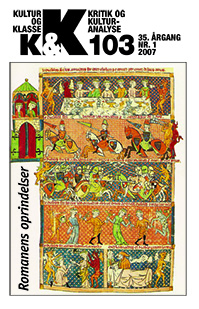Romanhistorie og topik: Kvinde-vogn-mand
DOI:
https://doi.org/10.7146/kok.v35i103.22301Keywords:
Romanhistorie, topik, kvinde, vogn, mand, 17. og 18. århundrede, historie, social, tilstandAbstract
History of the novel and topica: Woman-carriage-man
The aim of the article is to analyse the function of the carriage in the European novel in the 17th and 18th centuries. The article is divided into three parts: the first one describes the historical, material, juridical and sociological conditions determining the carriage in the 17th century as a bourgeois object. The second part analyses the specific literary function of the carriage. Whereas »normal« carriages have the function of transferring people between two geographically fixed points, the function of the literary carriage is that of making this very transfer break down accidentally. In a very homogenous way passages from Furetière, Marivaux, Defoe, Diderot and Goethe all demonstrate the functioning of such a chance principle. As these passages also have the conventional function of bringing a couple together in the carriage, a new idea of love as a fundamentally contingent category is in fact the cultural offspring of these chance encounters in carriages.
Downloads
Published
How to Cite
Issue
Section
License
Tidsskriftet følger dansk ophavsret.





